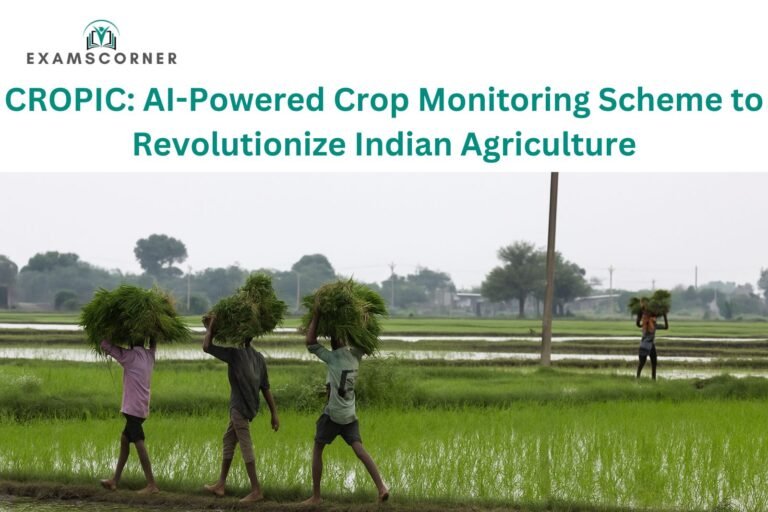The Ministry of Agriculture and Farmers Welfare is set to launch CROPIC (Collection of Real-Time Observations & Photos of Crops), a groundbreaking initiative leveraging artificial intelligence (AI) and mobile technology to monitor crop health, assess damage, and streamline insurance claims under the Pradhan Mantri Fasal Bima Yojana (PMFBY).
This innovative scheme aims to transform agricultural data collection by using crowdsourced field photographs analyzed through AI models, ensuring real-time crop monitoring and automated loss assessment. Here’s everything you need to know about CROPIC and how it will benefit Indian farmers.
What is CROPIC?
CROPIC (Collection of Real-Time Observations & Photos of Crops) is a digital crop monitoring system that collects field photographs at different stages of crop growth and uses AI-based analytics to assess crop health, detect damage, and estimate yield losses.
Key Features of CROPIC:
- Mobile App-Based Data Collection: Farmers and officials will upload crop photos via the CROPIC mobile app developed by the Agriculture Ministry.
- AI-Powered Analysis: An AI-based cloud platform will analyze images to determine crop type, growth stage, stress factors, and damage extent.
- Automated Insurance Claims: The system will help in fast-tracking compensation under PMFBY by providing verified crop loss data.
- Dashboard Visualization: A centralized web dashboard will provide real-time insights for policymakers and agricultural experts.
How Will CROPIC Work?
1. Field Photo Collection:
- Farmers and field officers will click 4-5 photographs of crops during their growth cycle.
- Images will be geotagged and timestamped to ensure accuracy.
2. AI-Based Analysis:
- The CROPIC AI model will process images to detect:
- Crop type (wheat, rice, maize, etc.)
- Growth stage (sowing, flowering, harvesting)
- Stress indicators (pests, diseases, drought)
- Damage assessment (extent of loss due to weather or pests)
3. Automated Compensation Processing:
- Insurance claims under PMFBY will be processed faster using verified AI data, reducing delays and fraud.
4. National Rollout Plan:
- Pilot Phase (2025-26): 50 districts in kharif 2025 & rabi 2025-26 seasons.
- Full Implementation (2026 onwards): Expansion to all PMFBY-notified crops nationwide.
Why is CROPIC Significant?
1. Real-Time Crop Monitoring
- Helps in early detection of crop stress, allowing timely interventions.
- Supports precision agriculture by providing data-driven insights.
2. Faster Insurance Claims
- Reduces manual verification delays in PMFBY claims.
- Ensures transparent and accurate compensation for farmers.
3. Digital Agriculture Boost
- Part of India’s push for AI and IoT in farming.
- Aligns with Digital India and AgriStack initiatives.
4. Better Policy Decisions
- Provides real-time data for government schemes like PM-KISAN, soil health cards, and climate-resilient farming.
Future of CROPIC & AI in Indian Agriculture
The Agriculture Ministry plans to integrate CROPIC with other AI-driven agri-tech projects, such as:
- Kisan Drones for aerial crop monitoring.
- e-NAM (National Agricultural Market) for better price discovery.
- Weather-based advisories via the IMD (India Meteorological Department).
Once fully operational, CROPIC could become a global benchmark for AI-powered crop insurance and yield estimation.
Conclusion
CROPIC is a game-changer for Indian agriculture, combining crowdsourcing, AI, and mobile tech to ensure better crop management, faster insurance payouts, and data-driven farming. By reducing human error and delays, this initiative will empower farmers, improve food security, and modernize India’s agricultural ecosystem.
With its nationwide rollout expected by 2026, CROPIC could set a new standard for smart farming not just in India, but across the world.
Sources:
- Ministry of Agriculture & Farmers Welfare (agriculture.gov.in)
- Pradhan Mantri Fasal Bima Yojana (PMFBY) (pmfby.gov.in)
- Digital India Agriculture (digitalindia.gov.in)
Also Read: National Conference on Agri Stack: Transforming Agriculture Through Data-Driven Solutions



